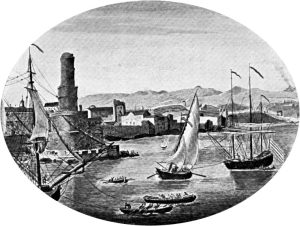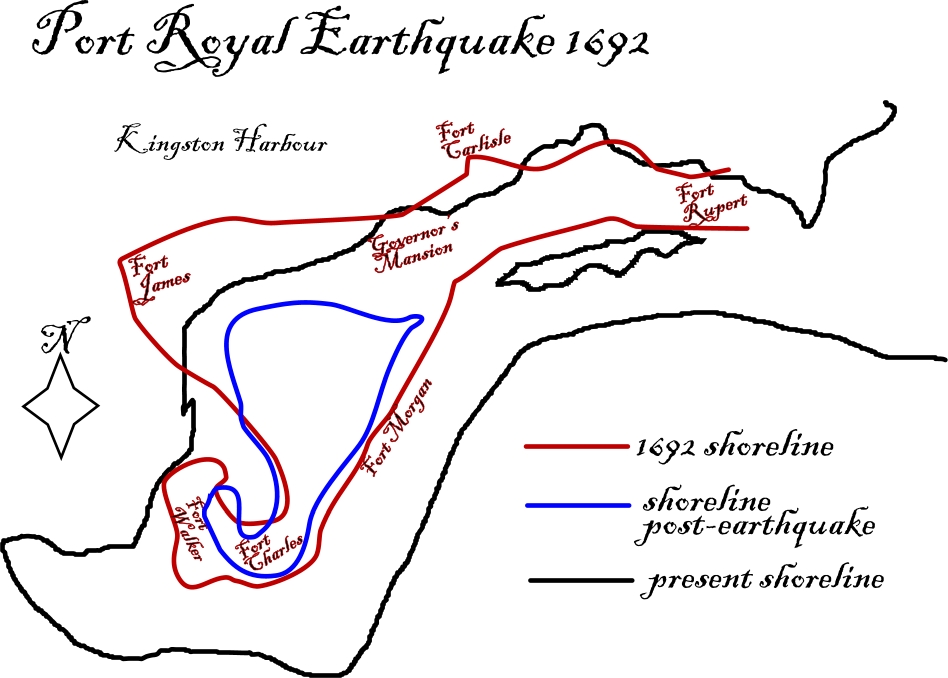In the tale of Atlantis related by Plato, the island sinks into the sea. While today nearly all historians and archaeologists consider Atlantis a myth, there is one story that true and that is the sinking of Port Royal into the Caribbean Sea on 7 June 1692.

Public Domain via Wikimedia Commons
Port Royal was located in southeast Jamaica on the peninsula of Kingston Harbor. It was founded in 1494 by the Spanish though the area where Port Royal was located was of little interest to them. Jamaica was an important island strategically for them since it was located inside the major trade routes. The Spanish primarily used the island for sugar cane and would remain under Spanish control until the British seized it in 1655.
The British added houses, shops, warehouses, and two forts into the area that would be called later Port Royal (it was originally called Cagway). Port Royal would be the unofficial capital of Jamaica (though Spanish town was the official capital under the 19th century when Kingston was made the capital. Privateering found a convenient home in Port Royal. With its easy access to the Spanish Main, privateers carrying Letters of Marque (a document issued by the government authorizing the private person to raid ships of their enemies) could easily attack and bring back their spoils to sold for profit. It also had a large and well protected harbor for the privateers to return to and get ships repaired. Many well-known buccaneers of the period used Port Royal as their base of operations. Between the British Royal Navy and these privateers, the Spanish were on the defense. Additionally, it made it difficult for them to resupply their colonies or ship items home. Thus Spanish, with trade interrupted by ships captured by privateers, were forced to buy their supplies from merchants who got their them from privateers. It was a system called Forced Trade.
Port Royal became a city tied to the fortunes of the privateers as they raided Spanish ships and towns. They privateers received a great deal of money from bringing the items back to Port Royal where merchants would buy them. From all accounts, just about everyone in Port Royal benefited in one way or another from the privateers. Port Royal became a fast-growing city reaching up to 6,500 people at its height making it one of the largest cities in the Caribbean. It also acquired a reputation for its gaudy display of wealth and the large numbers of privateers that lived there. It became widely known as a place of loose morals as well. There were numerous taverns (one for every 10 people), prostitution was widely in use, and money was spent freely causing many of the privateers to go broke. There were also goldsmiths and merchants of all kinds to sold or bought products from the privateers. The city ran out of room due to the increased population, so they had to fill in areas and build on it or build structures above the water (sort of like Venice). While there were some advice buildings should be built with wood and build them low, many opted to build with bricks not realizing they were not building on bedrock but sand.
By 1692, the need for privateers had diminished for the British with the Treaty of Madrid in 1670 ended their need to raid Spanish ships and cities. Henry Morgan, one of the famous and celebrated privateers of the era, would end up serving in the Jamaican government and even its governor at times. Privateers would still use Port Royal, but they had to be sure never to attack British ships. Morgan could no longer issue Letters of Marque but the French needed them, so they would sail for France against, you guessed it, the Spanish. Morgan received a payment for each Letter of Marque that was signed. It did cause problems for Morgan since some said he was helping the French against the Spanish. France though had become a major threat to the British. Morgan was replaced as governor (he only held the position when the person appointed was away or vacant). During his times as governor he increased defenses of the island from the French. But the accusations (falsely made it seems) would doom him and he would be out of power (except for a brief period) and died in 1684.
Changing attitudes also occurred as well. While many privateers had done service for the realm, pirates were a threat to everyone. And many people in Port Royal had tired of the drunkenness and other things that had given the city quite a sordid reputation. Anti-piracy laws enacted in 1687 turned Port Royal into a place where pirates were executed rather than tolerated. Ships called there and many sailors spent their money in taverns and other places, but pirates were now executed when caught or imprisoned. Then on 7 June 1692 around 11:43 a.m., everything would change. Three massive earthquakes hit Jamaica but was hardest on Port Royal. Buildings built over the water or filled in areas collapsed. Also, the peninsula was mostly sand and soil liquefaction occurred collapsing buildings as they sank. Then to make matters even worse, the tsunami created by the earthquakes struck putting half of Port Royal under water. Nearby Spanish Town was destroyed, and landslides claimed victims as well inland.
Over 3,000 people were killed outright by the earthquakes and tsunami. Many more died later from the looting, from injuries, and from diseases. The wicked pirate city as it was called was gone. While parts of it still remained, it was never rebuilt (subsequent attempts ran into real difficulties) and Kingston became more important as a result. Today there is an effort to restore a small part of it for tourist and also to make it a world heritage site. A large floating pier for cruise ships has been built but much more needs to be done according to news reports. A lot of study by geologists, historians, oceanographers and others of the remains under the sea is being done to understand how it happened. Port Royal, once the haven for pirates, has become known as the city that sank. Many actually were happy to see it suffer its fate from some writings of that time.

Public Domain via Wikimedia Commons
Sources
Ugc. “Sunken Pirate City at Port Royal.” Atlas Obscura, 3 June 2024, www.atlasobscura.com/places/sunken-pirate-stronghold-at-port-royal.
“Port Royal | Jamaica, Map, History, and Earthquake.” Encyclopedia Britannica, 4 June 2024, www.britannica.com/place/Port-Royal-Jamaica.
“Letter of Marque | Definition and Examples.” Encyclopedia Britannica, 14 Nov. 2017, www.britannica.com/topic/letter-of-marque.
“Earthquake Destroys Jamaican Town.” HISTORY, 6 June 2024, www.history.com/this-day-in-history/earthquake-destroys-jamaican-pirate-haven.
Vallar, Cindy. Pirates and Privateers: The History of Maritime Piracy – Pirate Havens Port Royal. www.cindyvallar.com/havens4.html.
“Port Royal.” Wikipedia, 3 June 2024, en.wikipedia.org/wiki/Port_Royal.
Documentaries & Films
The History Guy: History Deserves to Be Remembered. “Pirates and the Earthquake That Destroyed Port Royal.” YouTube, 7 June 2017, www.youtube.com/watch?v=EypOHCv2JsY.
NTIONAL GEOGRAPHIC WILD. “Best Documentary History of Port Royal Underwater Cities.” YouTube, 22 Jan. 2017, www.youtube.com/watch?v=B1VLUevIWIs.
Titanic News Channel is a participant in the Amazon Services LLC Associates Program, an affiliate advertising program designed to provide a means for sites to earn advertising fees by advertising and linking to Amazon.com.

